The Ultimate Guide to Ice Climbing
Ice climbing has its roots in the early days of mountaineering when climbers encountered icy and snowy peaks during their expeditions. In the 1960s and 1970s, a group of dedicated ice climbers started pushing the limits of what was thought possible. They developed specialized equipment and techniques to take on increasingly difficult ice formations. Today, ice climbing has grown into its own unique sport, with a dedicated community of climbers and many opportunities for adventure all over the world.
Whether you've been dreaming of taking on famous routes in the Canadian Rockies or are simply interested in learning more about this exciting sport, keep reading to explore the thrilling world of ice climbing.
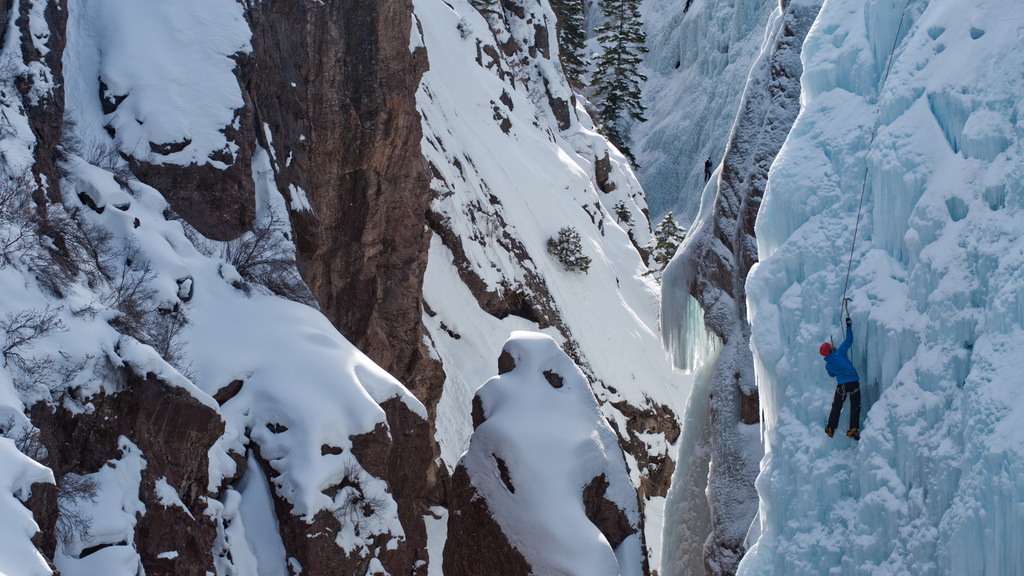
Types of Ice Climbing
Understanding the different types of ice climbing will help you choose the best approach for your skills, interests, and available resources.
- Alpine Ice Climbing: This style involves ascending ice formations found in high-altitude mountain environments, often as part of a larger mountaineering objective. Alpine ice climbs can range from moderate-angle glaciers to steep, technical faces and ridges. Climbers must be prepared for variable weather conditions, remote locations, and the need for self-sufficiency.
- Waterfall Ice Climbing: Waterfall ice forms when flowing water freezes into vertical or near-vertical formations, creating a stunning and challenging canvas for climbers. These routes can range from short, accessible climbs to multi-pitch adventures requiring a full day or more. Waterfall ice climbing is often more accessible than alpine climbing, with many popular destinations located near roads and towns.
- Mixed Climbing: Mixed climbing involves ascending routes that combine ice and rock, requiring climbers to use a variety of techniques and gear. Mixed routes can be found in both alpine and waterfall settings, and often involve intricate sequences of rock moves and ice tool placements. This style of climbing demands a high level of technical skill and creativity.
- Dry Tooling: Dry tooling is a discipline that involves using ice climbing tools and techniques on rock, often in the absence of ice. This style has evolved from mixed climbing and is popular among climbers looking to push their limits on steep, gymnastic routes. Dry tooling can be practiced on natural rock or on artificial structures designed specifically for training.
Check out one of our members at On The Rocks practicing his Dry Tooling on our walls!
Most climbers that want to get into ice climbing begin with top-roped waterfall ice or moderate alpine routes, gradually progressing to more challenging and committing objectives as their skills and confidence grow.
"Ice climbing is a beautiful, challenging sport that rewards dedication and perseverance. Whether you're drawn to the aesthetic beauty of frozen waterfalls or the remote solitude of an alpine face, there's a lifetime of adventure waiting to be discovered." - Nick Flock, ice climber enthusiast
Essential Ice Climbing Gear
When you're getting ready to start ice climbing, having the right gear is really important. It will help keep you safe and make your climbing experience more fun. As you shop for your first set of gear, look for high-quality, dependable equipment from well-known brands. It might seem like you're spending a lot of money at first, but good gear is worth it. It will last for many climbing seasons and give you the performance and protection you need when you're facing tough conditions on the ice.
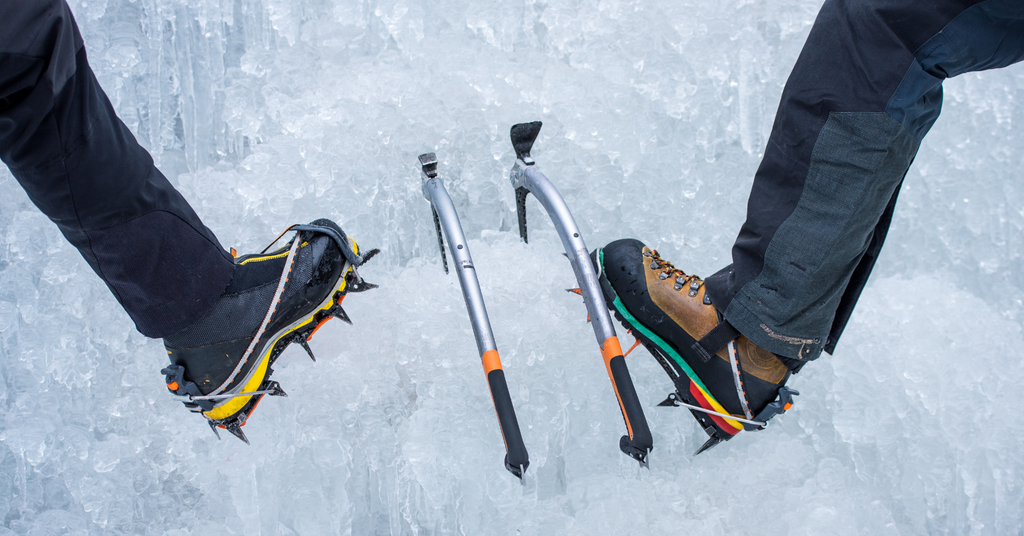
- Ice Axes: Ice axes, also known as ice tools, are the primary means of ascending ice. Modern ice axes feature curved shafts, ergonomic grips, and replaceable picks designed for optimal placement and removal. When choosing ice axes, consider the type of climbing you'll be doing and look for tools with comfortable grips, adjustable triggers, and a balance of swing weight and precision.
- Crampons: Crampons are spikes that attach to your boots, providing traction on ice and snow. For ice climbing, look for vertical front-point crampons with a rigid frame and adjustable bindings. Make sure your crampons are compatible with your boots and securely fastened before each climb.
- Boots: Ice climbing boots should be rigid, insulated, and compatible with your crampons. Look for boots with a waterproof gaiter, removable liners, and a sturdy sole for kicking steps in snow. Many climbers wear lightweight mountaineering boots for alpine ice and more technical boots for waterfall climbing.
- Harness and Helmet: A climbing harness and helmet are essential for safety. Choose a harness with adjustable leg loops, gear loops for organizing equipment, and a belay loop rated for climbing. Your helmet should be lightweight, adjustable, and designed for climbing, with good coverage and ventilation.
- Ropes, Carabiners, and Belay Devices: Dynamic climbing ropes, locking carabiners, and belay devices are used to protect climbers from falls and facilitate safe descent. For ice climbing, use dry-treated ropes to prevent water absorption and freezing. Familiarize yourself with proper belay techniques and always double-check your systems before climbing.
- Ice Screws and Quickdraws: Ice screws are used to create anchors and protect climbers on lead. Look for screws with sharp teeth, comfortable handles, and a range of lengths for different ice conditions. Quickdraws are used to connect the rope to ice screws, creating a secure and efficient protection system.
- Clothing Layers: Dressing in layers is key to staying warm and dry in cold environments. Start with a moisture-wicking base layer, add insulating mid-layers, and finish with a waterproof and breathable outer shell. Don't forget warm gloves, a hat or hood, and gaiters to keep snow out of your boots.
When you're buying gear, it's more important to focus on safety and quality than on saving money. For your first few ice climbing trips, renting or borrowing equipment can be a smart choice. But as you get better and spend more time climbing, investing in your own gear is a good idea. When you have your own equipment, you can customize it to fit your needs and preferences. Plus, you'll get to know your gear really well, which is important for safety and performance.
Ice Climbing Techniques and Skills
As you get better at ice climbing, focus on learning the basics really well first. Then, start adding in more advanced skills as you go.
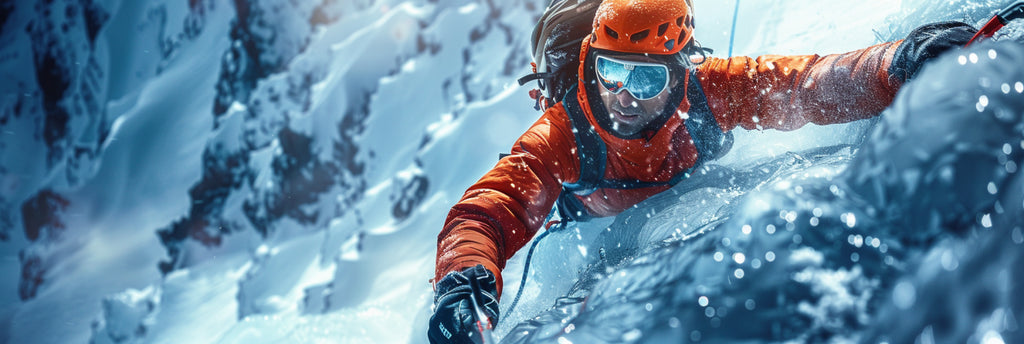
- Using Ice Axes and Crampons: Start by learning how to hold your ice axes and position your crampons for good balance and efficiency. Practice swinging your tools and kicking your feet to make secure placements in the ice. Find a rhythm and try to keep your body low and close to the ice.
- Footwork and Body Position: Good footwork is really important for ice climbing. It helps you save energy and stay in control on steep ice. Keep your heels low and your toes pointed into the ice, using the front points of your crampons to make precise placements. Keep your feet about shoulder-width apart and don't grip your tools too tightly. Instead, use your feet and legs to hold your weight.
- Placing and Removing Ice Screws: Learn how to place ice screws quickly and securely to protect yourself and your partner. Look for solid, even ice and avoid sections with cracks or hollow spots. Use your body weight to drive the screw in, and always clip the rope or a quickdraw to the hanger before you keep climbing. When removing screws, twist them steadily to avoid damaging the threads.
- Belaying and Managing the Rope: Belaying is a super important skill for ice climbing. It means controlling the rope to protect your partner if they fall. Practice good belay techniques, like keeping a firm grip on the rope, keeping the rope tight, and being ready to catch falls. Use a hands-free belay device for extra safety and always double-check your system before climbing.
- Leading and Following on Ice: When you lead on ice, you place protection and navigate the route while your partner belays from below. As a leader, try to keep a steady pace, save energy, and place solid protection regularly. When following, use your tools and crampons to remove gear and keep the rope tight. Be ready to catch a fall if needed.
- Judging Ice Quality and Stability: Learning to "read" ice is a key skill for safe and efficient climbing. Look for signs of unstable ice, like cracks, hollow sounds, or water flowing behind the ice. Avoid climbing on sun-baked or rotten ice, and always test questionable ice before trusting it. As you gain experience, you'll develop a feel for ice quality and learn to choose the safest and most fun lines.
Remember, getting really good takes time and practice, so be patient with yourself and celebrate your progress along the way!
"Ice climbing is one of the few sports in which the arena (the cliffs, the mountains and their specific routes) acquire a notoriety that outpopulates, outshines and outlives the actual athletes." - Jonathan Waterman
Safety Considerations
Ice climbing can be dangerous, so it's important to always think about safety and be aware of the risks.
- Check the weather and avalanche risk: Before you go ice climbing, always check the weather forecast and avalanche warnings for the area you'll be in. If the conditions aren't safe, like if there's a lot of snow, strong winds, or warmer temperatures, be ready to change your plans or cancel your trip. Learn how to spot signs of dangerous snow, like recent avalanches, cracking or collapsing snow, and hollow-sounding ice.
- Watch out for dangers: Ice climbing areas are always changing, so stay alert for falling ice or rocks, especially when the weather is changing or the sun is shining directly on the ice. Don't climb under or near other people, and always wear a helmet to protect your head. Be careful of hidden crevasses on glaciers and use ropes properly to stay safe.
- Use your safety gear correctly: Your safety gear only works if you use it the right way. Always wear a harness and helmet, and double-check your knots and belay setup before you start climbing. Put ice screws in often and in solid ice, and use quickdraws to keep the rope running smoothly. Be ready to stop yourself with your ice axe if you slip or fall on snow.
- Know first aid and rescue skills: Learn basic first aid and rescue skills for ice climbing. Know how to treat common injuries like frostbite, hypothermia, and injuries from falls. Practice self-rescue skills like climbing up a rope or building an anchor to get out of a crevasse. Think about taking a wilderness first aid or rescue course to learn more.
- Climb with a partner: Ice climbing is a team activity, so it's important to climb with a partner you trust and who has experience. Talk about your plans, how you'll use protection, and what to do in an emergency before you start climbing. Check in with each other often to make sure both partners feel safe and secure.
- Bring a way to communicate in emergencies: Carry a phone or satellite messenger in case of an emergency. Know how to use it and keep it where you can reach it and protected from the cold and wet. Leave your plans with someone responsible and set up a schedule to check in with them, so they can get help if needed.
“Accidents on big mountains happen when people’s ambitions cloud their good judgment. Good climbing is about climbing with heart and with instinct, not ambition and pride.” – Bear Grylls
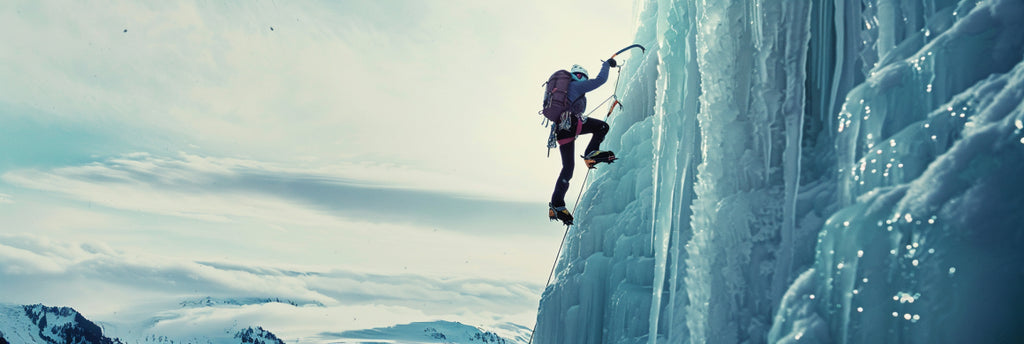
Remember, safety is a shared responsibility among all members of a climbing team. Speak up if you have concerns about a route or your partner's actions, and be willing to make conservative decisions in the face of uncertainty.
"No climb is worth risking your life for. The most important thing is to come home safely at the end of the day. Trust your instincts, and never let ego or pressure cloud your judgment." - Ines Papert, German ice climber and alpinist
Training and Preparation
Whether you're a beginner or an experienced climber looking to push your limits, investing time and effort into building your skills and fitness will pay dividends on the ice.
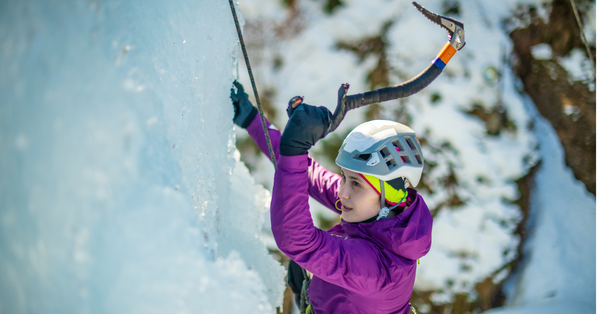
- Physical Conditioning: Ice climbing is a physically demanding activity that requires strength, endurance, and flexibility. Focus on exercises that target your core, upper body, and legs, such as pull-ups, push-ups, squats, and lunges. Incorporate cardiovascular training, such as running or cycling, to build endurance and improve your overall fitness. Regular yoga or stretching can help maintain flexibility and prevent injuries.
- Mental Preparation and Focus: Ice climbing also demands mental toughness and the ability to remain focused and composed in challenging situations. Practice visualization techniques, imagining yourself successfully completing difficult moves or overcoming fear. Cultivate a positive attitude and learn to manage stress through breathing exercises or meditation. Set realistic goals and celebrate your progress, but also be willing to back off when necessary.
- Indoor Training Facilities and Drytooling: Many climbing gyms offer indoor ice climbing walls or drytooling facilities, which allow you to practice your skills and build strength in a controlled environment. Take advantage of these resources to work on your technique, experiment with different tools and configurations, and gain confidence on steep terrain. Consider hiring a coach or taking a class to refine your skills and learn from experienced climbers.
- Choosing Appropriate Routes for Your Skill Level: As you transition from indoor to outdoor climbing, be honest about your abilities and choose routes that are appropriate for your skill level. Start with well-protected, moderate climbs and gradually progress to more challenging terrain as your skills and confidence grow. Research potential routes using guidebooks, online resources, and local knowledge, and be prepared to adjust your plans based on conditions and your own comfort level.
- Finding Experienced Mentors or Guides: One of the best ways to learn and progress as an ice climber is to seek out experienced mentors or hire a qualified guide. Look for climbers with a strong track record of safety and a willingness to share their knowledge. Consider joining a local climbing club or attending a clinic or festival to connect with other climbers and expand your skills. When climbing with a mentor or guide, be an active learner, asking questions and seeking feedback on your technique and decision-making.
- Gradually Progressing to More Challenging Climbs: As you gain experience and confidence, you may find yourself drawn to more challenging and committing ice climbs. Take a gradual approach to progression, building your skills on incrementally harder routes and seeking out climbs that push you outside your comfort zone. Be honest with yourself about your abilities and limitations, and don't hesitate to back off if a climb feels beyond your current level.
Remember, the learning process never ends in ice climbing. Embrace a beginner's mindset, stay curious and open to new ideas, and never stop seeking opportunities to grow and improve.
"The best climber in the world is the one having the most fun." - Alex Lowe, legendary American alpinist and ice climber
Popular Ice Climbing Destinations
One of the best things about ice climbing is getting to explore some of the world's most beautiful and unique places. From the huge ice walls of the Canadian Rockies to the remote mountain faces of Patagonia, there are so many amazing destinations that offer awesome ice climbing for climbers of all skill levels.
- North America: The United States and Canada have some of the most famous and easy-to-get-to ice climbing spots in the world. The Canadian Rockies, which stretch from Alberta to British Columbia, have enough classic climbs to last a lifetime. There are massive multi-pitch routes on the Icefields Parkway and steep pillars in the Ghost Valley. In the US, Colorado's Ouray Ice Park is a big deal for climbers, with over 200 routes of different difficulties. Other cool places to check out include the White Mountains of New Hampshire, the Hyalite Canyon of Montana, and the frozen waterfalls of Michigan's Upper Peninsula.
- Europe: The European Alps are a big part of climbing history and have a wide range of ice climbing options across France, Switzerland, Italy, and Austria. Chamonix, France, is a popular spot for mountain climbers and ice climbers, with classic routes like the Chèré Couloir and the Argentière Glacier. Norway's Rjukan Valley is known for its long, consistent ice routes, while the Dolomites of Italy offer a cool mix of rock and ice climbing in a beautiful mountain setting. Other notable destinations include the Ecrins mountains in France, the Kandersteg region of Switzerland, and the Lyngen Alps of Norway.
- Asia: The Himalaya and Karakoram mountain ranges in Asia are the ultimate test for serious ice climbers and mountaineers. Pakistan's Trango Towers and India's Miyar Valley have some of the world's highest and most challenging ice routes, while the frozen waterfalls of Japan and South Korea are more beginner-friendly and easier to get to. China's Sichuan Province has a growing ice climbing scene, with incredible routes like the 1,000-foot Maoniu Waterfall.
- South America: Patagonia, the wild and remote region on the border of Chile and Argentina, is a dream destination for serious ice climbers. The huge granite spires of Cerro Torre and Fitz Roy have some of the world's toughest and most famous mixed routes, which require a combination of rock, ice, and mountain climbing skills. The Cochamó Valley of Chile has a variety of frozen waterfalls and alpine ice routes, while the Cajón del Maipo near Santiago offers easy-to-get-to cragging in a stunning Andes mountain setting.
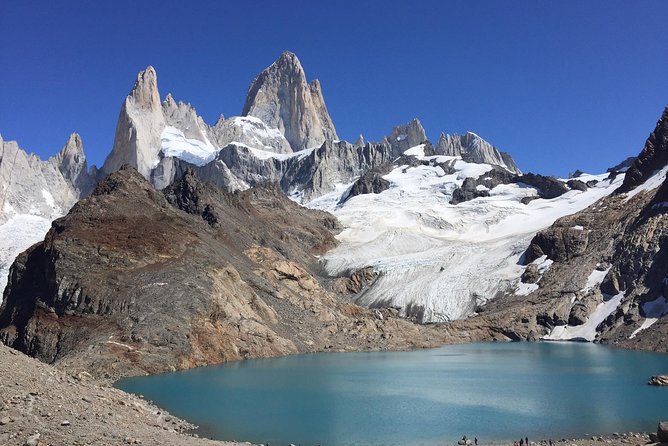
No matter where your ice climbing adventures take you, remember to respect the local environment, culture, and climbing community. Take time to research access issues, ethical considerations, and leave-no-trace principles before your trip. Always prioritize safety and being self-sufficient in remote or unfamiliar areas.
"Climbing is not just about reaching the summit, but about the journey, the partnerships, and the personal growth along the way. Choose objectives that inspire you, challenge you, and allow you to experience the full richness of the climbing life." - Conrad Anker, American alpinist and ice climber
Ice Climbing Etiquette and Environmental Impact
As ice climbing becomes more popular, it's really important for climbers to be respectful and minimize their impact on the fragile environments where we climb.
- Respect Other Climbers and Local Rules: When you get to a climbing area, take a moment to observe and respect any local traditions or ethics. Let faster groups pass on multi-pitch routes, and communicate clearly with other climbers to avoid conflicts or crowding. Follow all posted rules about parking, access, and camping, and be respectful of private property and local residents.
- Minimize Damage to Ice: Ice climbing does have some impact on the frozen environment, but we can take steps to minimize our footprint. Avoid chipping or hacking at the ice unnecessarily, and use good tool and crampon technique to avoid damaging delicate features. Rappel or lower carefully to avoid knocking off big chunks of ice, and consider using v-threads or other low-impact anchors when possible.
- Dispose of Waste Properly and Protect Alpine Ecosystems: Pack out all trash and waste, including food scraps, wrappers, and human waste. Use designated restroom facilities when available, or follow local guidelines for waste disposal in remote areas. Be careful not to trample or damage sensitive alpine vegetation when approaching or descending from climbs.
- Support Local Economies and Conservation Efforts: Ice climbing can have a positive impact on local communities by bringing in tourism dollars and supporting small businesses. When visiting climbing destinations, try to support local shops, restaurants, and guide services. Consider donating to local conservation or access organizations that work to protect the areas where we climb, and participate in volunteer stewardship events when possible.
"We are all visitors in the vertical world, and it's our responsibility to leave it better than we found it. By practicing good etiquette and minimizing our impact, we can help ensure that future generations have the same opportunities for adventure and inspiration that we do." - Will Gadd, professional ice climber and paraglider pilot
Conclusion
As you continue to develop your skills and experience, remember to celebrate your progress and embrace the challenges and setbacks as opportunities for growth. Ice climbing is a lifelong pursuit, and the learning process never ends. Stay curious, stay humble, and never stop seeking out new opportunities to push your limits and expand your horizons.
Above all, remember that ice climbing is about more than just reaching the top of a frozen cascade or alpine face. It's about connecting with the beauty and power of the natural world, and finding our own place within it.
The vertical world of ice awaits, and the possibilities are endless.

